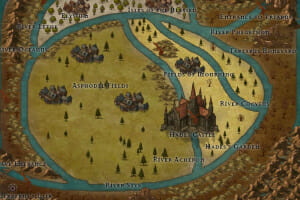The Five Rivers of the Underworld and Their Uses in Greek Mythology
 The rivers of the Underworld were believed to be in the earth’s bowels in the domain of Hades, the god of the Underworld. Each river had unique characteristics, and each personified an emotion or a deity after which they were named. The Underworld, in Greek mythology, was a physical place that had the Asphodel meadows, Tartarus, and Elysium, which answers the question ‘what are the three areas of the Underworld?’ Read on to discover the names of the rivers that flowed in the earth’s bowels and their functions.
The rivers of the Underworld were believed to be in the earth’s bowels in the domain of Hades, the god of the Underworld. Each river had unique characteristics, and each personified an emotion or a deity after which they were named. The Underworld, in Greek mythology, was a physical place that had the Asphodel meadows, Tartarus, and Elysium, which answers the question ‘what are the three areas of the Underworld?’ Read on to discover the names of the rivers that flowed in the earth’s bowels and their functions.
The Five Rivers of the Underworld
Ancient Greek mythology speaks of five distinct rivers in the region of Hades and their functions. The names of the rivers are Styx, Lethe, Acheron, Phlegethon, and Cocyton. These rivers flowed through and around the domain of the dead and represented the harsh realities of death. All these rivers were believed to converge into one great marsh, sometimes referred to as Styx.
River Styx
The river Styx was the most popular infernal river that served as a boundary between the land of the living and the realm of the dead. Styx means “hatred” and symbolizes the nymph who resided at the entrance of the Underworld.
The nymph Styx was the daughter of Oceanus and Tethys, who were both Titans. Thus the Greeks believed that the river Styx flowed out of Oceanus. The river Styx was also thought to have miraculous powers derived from the nymph that bore its name.
Functions of Styx
The river Styx was where all the gods of the Greek pantheon swore their oaths. For instance, Zeus swore on the Styx that his concubine Semele could ask him anything and he would do it.
Then to the horror of Zeus, Semele asked him to reveal himself in his full splendor which he knew would kill her instantly. However, since he had already sworn by the Styx, he had no choice but to go through with the request which sadly ended Semele’s life.
Also, the river had the powers to make one invulnerable and near-immortal as demonstrated by Achilles’ mother. When he was a boy, his mother Tethys dipped him in the Styx to make him indestructible except for his heel where she held.
The souls of the dead were transported on the Styx from the land of the living and the further down the river a soul was sent, the greater the punishment. The people of ancient Greece believed that the dead had to pay for the transport on the Styx, therefore they placed a coin in the deceased’s mouth during the burial.
River Lethe
The next river known as Lethe symbolizes forgetfulness and the dead are expected to drink from it to forget about their past. Just as Styx, Lethe was also the name of the goddess of forgetfulness and oblivion who was birthed by Eris, the goddess of Strife and discord.
She was a guardian of the underworld who stood in the court of the deity of sleep known as Hypnos. Throughout history, Lethe has been associated with Mnemosyne, the goddess of memory.
Functions of Lethe
As already mentioned, the souls of the departed were made to drink the Lethe before their reincarnation. In Plato’s literary work, Republic, he indicated that the die landed on a deserted wasteland known as Lethe with the river Ameles running through it. The souls of the deceased were then made to drink from the river and the more they drank, the more they forgot about their past. However, some religions during the Greco-Roman period taught that there was a second river known as Mnemosyne that enabled its drinkers to regain their memory.
In recent times, a small river that flows between Portugal and Spain was believed to have the same power of forgetfulness as the Lethe. Thus, it was erroneously referred to by the same name (Lethe) with some soldiers under the Roman general Decimus Junius Brutus Callacious refusing to cross the river for fear of losing their memory.
The soldiers, however, overcame their fear when their commander crossed the dreaded river and called on them to do the same. The river Guadalete, in Spain, was originally named Lethe as part of a truce between local Greek and Phoenician colonists after they promised to forget their differences.
The Acheron River
Another mythical river in the Underworld is Acheron. Acheron (32.31mi) ushers the dead into the realm of Hades and it personifies misery or woe. The Roman poet, Virgil, referred to it as the main river that flowed through Tartarus and from which the rivers Styx and Cocytus came.
Acheron was also the name of the river god; the son of Helios (the sun god) and either Demeter or Gaia. According to Greek mythology, Acheron was transformed into an Underworld river after giving the Titans water to drink during their war with the Olympian gods.
Functions of River Acheron
Some ancient Greek myths also narrate that Acheron was the river on which the souls of the departed were transported by the minor god Charon. The 10th Century Byzantine encyclopedia, Suda, described the river as a place of healing, cleansing, and the purging of sins. According to the Greek philosopher Plato, the Acheron was a windy river where the souls went to await an appointed time after which they came back to earth as animals.
Currently, a river that flows in the Epirus region in Greece is named after the infernal river, Acheron. The Acheron flows from the village of Zotiko into the Ionian sea at a small fishing village known as Ammoudia.
Some ancient Greek writers used Acheron as a synecdoche for Hades thus the Acheron river came to represent the Underworld. According to Plato, Acheron was the most incredible river among the rivers of the Underworld Greek mythology.
The River Phlegethon
The Phlegethon was known as the river of fire, with Plato describing it as a stream of fire that flowed around the earth and ended in the bowels of Tartarus. According to legend, the goddess Styx fell in love with Phlegethon but she died when she came into contact with his fiery flames.
To reunite her with the love of her life, Hades allowed her river to flow parallel to that of Phlegethon. The Italian poet Dante wrote in his book Inferno, that Phlegethon was a river of blood that boils souls.
Functions of Phlegethon
According to Dante’s Inferno, the river is situated in the Seventh Circle of Hell and is used as a punishment for souls who committed grievous crimes while they were alive. The lot includes murderers, tyrants, robbers, blasphemers, greedy money lenders and sodomites. Depending on the grievous nature of the crime committed, each soul was assigned a specific level in the boiling river of fire. Souls who tried to rise above their level were shot at by centaurs who patrolled the borders of Phlegethon.
English poet Edmund Spenser also reiterated Dante’s version of Phlegethon in his poem The Faerie Queene which told of a fiery flood that fried damned souls in Hell. The river also served as a prison for the Titans after they were defeated and overthrown by the Olympians.
In one of the Persephone myths, Ascalaphus, the guardian of the Hades garden, reported Persephone for eating the forbidden pomegranates. Thus, she was punished to spend four months of each year with Hades.
To punish Ascalaphus, Persephone sprinkled the Phlegethon on him, turning him into a screech owl. Other writers such as Plato felt that the river was the source of volcanic eruptions.
The River Cocytus
Cocytus was known as the river of lamentation or wailing and it was believed to have its source from the Styx and flowed into the Acheron in Hades. Dante described the Cocytus as the ninth and last circle of Hell, referring to it as a frozen lake instead of a river. The reason was that Satan or Lucifer turned the river into ice by flapping his wings.
Functions of the Cocytus River
According to Dante, the river had four descending rounds, and souls were sent there depending on the type of crime they committed. Caina was the first round, named after Cain in the Bible and it was reserved for traitors to relatives.
The next was Antenora, representing Antenor of the Iliad, who betrayed his country. Ptolomea was the third round which symbolized the governor of Jericho, Ptolemy, who killed his guests; thus traitors to guests were sent there.
Then the last round was named Judecca, after Judas Iscariot, and was meant for people who betrayed their masters or benefactors. The banks of the Cocytus river was home to souls who did not receive a proper burial and thus served as their wandering grounds.
Summary:
So far, we’ve studied the five water bodies in the Underworld and their functions. Here is a summary of all that we’ve discovered:
- According to Greek mythology, there were five rivers in the domain of Hades, each with its function.
- The rivers were Styx, Lethe, Acheron, Phlegethon and Cocytus and their deities.
- Both Acheron and Styx served as boundaries between the world of the living and the dead while Phlegethon and Cocytus were used to punish evildoers.
- Lethe, on the other hand, symbolized forgetfulness and the dead were required to drink from it to forget their past.
All the rivers played significant roles in ensuring that the damned souls paid for their deeds and their mythologies served as a caution to the living to desist from evil.

